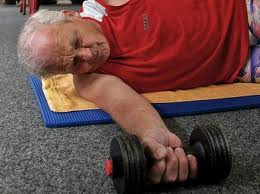In an obesity challenged society, physicians first recommend the elderly to maintain an optimal body mass index (a weight to height ratio) in order to prolong their lives. A better indicator and predictor for all-cause mortality, however, may be based on the muscle mass index, according to a recent research published in the American Journal of Medicine by a group from UCLA.

Dr. Preethi Srikanthan and colleagues analyzed data collected by the National Health and Nutrition Examination Survey (NHANES) III, conducted between 1988 and 1994. They focused on a group of 3,659 individuals that included men who were 55 or older and women who were 65 or older at the time of the survey. The authors then determined how many of those individuals had died from natural causes based on a follow-up survey done in 2004.
Muscle body mass hasn’t been the focus of longevity studies because, unlike BMI which is extremely simple to measure (you just weigh yourself) and can be standardized, there isn’t yet a totally and generally accepted method for measuring it. The body composition of the study subjects was measured using bioelectrical impedance, which is not the most advanced technique (the measurements are 20 years old), yet still effective. It involves running an electrical current through the body, then measuring it as it passes through.
The measured current is distinct according to your muscle mass, since muscle allows the current to pass more easily than fat does. Using this method, the researchers were able to establish a muscle mass index (amount of muscle relative to height) then sought to analyze how this parameter was related to the risk of death.
They found that all-cause mortality was significantly lower in the fourth quartile of muscle mass index compared with the first quartile.
“In other words, the greater your muscle mass, the lower your risk of death,” said Dr. Arun Karlamangla, an associate professor in the geriatrics division at the Geffen School and the study’s co-author. “Thus, rather than worrying about weight or body mass index, we should be trying to maximize and maintain muscle mass.”
“Despite these limitations, this study establishes the independent survival prediction ability of muscle mass as measured by bioelectrical impedance in older adults, using data from a large, nationally representative cohort,” Srikanthan and Karlamangla write, adding that BMI’s association with mortality in older adults has proven inconsistent. “We conclude that measurement of muscle mass relative to body height should be added to the toolbox of clinicians caring for older adults. Future research should determine the type and duration of exercise interventions that improve muscle mass and potentially increase survival in (healthy), older adults.


